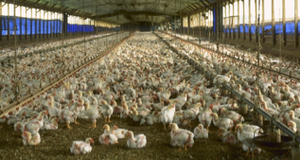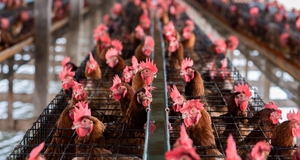From Discussions VOL. 10 NO. 3A New Approach to Ohio Pig Farming
IN THIS ARTICLE
KEYWORDS
Although current methods of pig farming now allow cheap pork availability to consumers throughout America, they come at high costs. Through interviews with Ohio pig farmers and research on current and historical developments in the industry, this article explains how the industry has achieved its current methods of production, how consumers and farmers are affected, and where everything should be headed in the near future. There are and will continue to be aspects of pig farming that affect the health of the general public and the health of future generations, and they need to be addressed in open discussion. While this topic often causes strong reactions from various invested groups, it is critical to consider a number of perspectives and integrate them with research to form a cohesive vision for the future. BackgroundCurrent, conventional methods of pig farming are generally as follows: sows are bred via artificial insemination, and once born, their tails are docked to keep other pigs from chewing on the tails in their future close quarters. Their teeth are also clipped in order to prevent infection. Once weaned, hogs are shipped sometimes several hundred miles to another facility to be raised on a diet of mostly corn, soybeans, and small amounts of antibiotics. They are kept in pens with many other hogs, and throughout their lives they are closed in a barn with their waste falling through slots into large pits below them. When the sows reach market weight, they are often switched to a different diet plan in order to achieve the slaughterer’s desired meat composition, and then shipped to another company to be butchered. The idealized picture of a typical pig farm that is still used in advertising campaigns by conventional companies has become increasingly rare in reality; they “remind us of a human-pig relationship that…was not always so distanced or as alienated as it is in the industrialized world today” (Mizelle 2011, p. 11). In the early 1800’s, livestock laws changed so that the purposes of fences were no longer to keep pigs out but to keep them in. This was quite a controversial decision in pig farming at the time because most Americans tended to allow their pigs free range of the land. This change was a fundamental development in the way pigs have been raised in this country and set pig farms on the path to the current conventional production. Cincinnati, Ohio was the epicenter of the development of the modern industrial pig farm. Despite the fairly decentralized state of hog businesses at the time, Cincinnati grew from 100,000 hogs processed annually in the 1830s to 400,000 annually in the 1840s. In the 1880s, centralization of this large-scale method of raising hogs came to fruition elsewhere due to technological advancements, specifically transportation (e.g. railroads) and refrigeration. In Cincinnati and many other cities, however, pigs remained in the public eye as “important players in urban ecologies and subsistence as well as a public nuisance” (Mizelle 2011). This more intimate relationship was gradually phased out, however, as cities wished to have a more civilized atmosphere. By the end of World War II, traditional hog farming that allowed the animals seasonal access to the outdoors had all but disappeared. The confined operations of today involving the use of antibiotics, corn and soybean feed, and division of growth stages among facilities became standard practice (Mizelle 2011). The start of the modern day conventional farm, sometimes called CAFO (Concentrated Animal Feeding Operation), is connected to Wendell Murphy, a US state senator who began as a pig farmer in 1962. Murphy strove to mimic the success that industrial chicken production had prior to the development of pig farming. In the 1980s and 1990s, he bought out many pig farms near him and had them move their entire business indoors, as the chicken farmers had done. He also split his farming process into three stages on three separate farms: breeding, growing, and preparing them for market (“Wendell” 2012). This proved to be extremely successful. In North Carolina, he worked within the state’s General Assembly to diminish the amount of power that the government had over hog farms. He also voted for and co-sponsored bills that gave hog farms tax breaks, excused them from some environmental regulation, and shielded them from local zoning requirements. During the ten years that he was on the General Assembly, he became the nation’s biggest hog producer. Murphy’s methods were duplicated throughout the country, and this soon became the norm in hog farming (Stith 2012). This pattern of modernization and development used to distance humans from animals can be seen globally (Mizelle 2011). Problems with Conventional Pig FarmingMedicalIn addition to contributing to growth rate, antibiotics are also constantly administered at low levels to conventional pigs because of their disease susceptibility. This is a controversial practice that began on European livestock farms in the 1970s in order to induce slightly higher growth rates in animals. The Food and Drug Administration (FDA) estimates that 80 percent of our current antibiotic use occurs in the livestock industry, which has led many researchers to document its effects (Xue 2014). Some studies – such as those on the banning of the antibiotic avoparcin in the EU as a livestock feed additive – indicate that eliminating antibiotics from livestock feed greatly reduces the overall prevalence of resistant strains while very minimally affecting the growth rate of livestock (Wegener 2003). It is estimated that antibiotic antibioticresistant diseases cause two million serious illnesses and 23,000 deaths every year in the United States alone, making this a critical issue to address in the pork industry (Xue 2014). Even though there has been definitive evidence of the effect of livestock antibiotics on resistant diseases in humans since the early 1980s, the FDA took its first action to phase the practice at the end of last year (Plumer 2013). Another medical practice that is now widespread in the industry is the use of artificial insemination (AI); currently over 90 percent of swine breeding uses this method (Mizelle 2011). Artificial insemination has made genetic uniformity in herds easy to generate, allowing producers to obtain consistent meat products. Unfortunately, genetically uniform herds are more susceptible to disease. Nathanael Johnson, a professor of the Graduate School of Journalism and guest writer for Harper Magazine, explains, “The pigs are vulnerable because they live in close quarters; and because they are genetically uniform, a bug that breaches the defenses of one pig’s immune system can hop to the next. A bacterium residing between a traveling boar’s toes could wipe out half a herd” (Johnson 2006, p. 2). Although farms take elaborate precautions in preventing contamination of their herds, this disease susceptibility has become especially evident with the recent spread of PED, or porcine epidemic diarrhea, which was discovered in Ohio farms in February of this year after already killing four million pigs across 23 states since April 2013 (FOX News 2014) Waste ManagementAside from disease, another critical problem faced by conventional pig farmers is pig waste. Seeing as hogs on average produce three times the amount of excrement as humans, the waste of these animals presents a significant dilemma. This is especially evident in the largest herds, ranging from 300,000 to 500,000 pigs on a single farm (Imhoff 2010). To put that in perspective, each of these farms has to take care of the amount of waste generated by the human population of Dallas, Texas. In a confined hog operation, the animals’ waste is collected underneath the barns in large pits, which are periodically emptied into nearby containment areas. As farmers are not responsible for treating this waste, there have been numerous instances of overflow from containment areas. These lagoons can contain tens of millions of gallons of wastewater, and they break, leak, or overflow too frequently. Concentrated animal waste of any kind can have dramatic effects on both people and ecosystems if it turns into pollutants. Unfortunately, using this concentrated waste as agricultural fertilizer often involves treatment, and even then, runoff from fields sprayed with pig farm waste that enters waterways is often far from safe (NRDC 2013). The low-quality waste management systems also provide pathways for the development of efficacious diseases. As mentioned before, the prevalence of disease in large herds of hogs is much higher than in smaller, less confined herds due to close proximity and concentrated waste of hogs in large herds. One example of how this can affect the spread of disease in humans is MRSA (methicillinresistant Staphylococcus aureus). This antibiotic-resistant disease originated in hospital wards where methicillin, a form of penicillin engineered after the bacterium became resistant to penicillin, was being used, but now it can be found outside of these environments (Xue 2014). MRSA carriage can be found on pig farms, especially larger farms. In one study, 34 percent of the animals in large-scale swine herds (>10000 pigs) carried the disease as opposed to seven percent on small-scale farms (Fang et al. 2014). This not only affects workers and neighbors of hog farms, but also those exposed to pig waste. Proximity to fields fertilized with waste from conventional pig farms has been shown to greatly increase the likelihood of MRSA infections (Zhang 2013). This disease has become a serious medical problem, with tens of thousands of people getting infected with MRSA every year, and over 11,000 of them dying (Xue 2014). Animal Welfare and NutritionIn conventional hog farming, the animals are provided with feed mostly consisting of corn and soybeans. This diet, although it produces the desired meat physique for the market, has multiple drawbacks. Primarily, the nutritional value of this diet is severely limited. Hogs are omnivores that are able to consume a variety of foods, potentially making them a highly nutritious meat source for humans, but conventional pork has minimal benefit in this area. This is one dramatic distinction between conventional and alternative farming approaches. For example, Nilzen et al. analyzed the nutrient value of meat from different physical pig farm models and found that free-range pigs had a higher polyunsaturated fatty acid content and a higher level of vitamin E compared to purely indoor pigs, which has to do with both diet and environmental factors (2001). In highly confined, noisy environments, it is not hard to predict behavior difficulties with the pigs. This was the case with a breeding facility called Oberholtzer Farm in Ashland, Ohio. This breeding facility is required to house the sows in pens of six to ten pigs when they are not gestating or farrowing (Kenneth Oberholtzer, personal communication, March 15, 2014). However, in confined areas there are often conflicts between the pigs, making it necessary to remove select pigs and put them in individual pens, which means extremely limited mobility. High anxiety levels in pigs, has been shown to be related to PSE, or “pale soft exudative” meat quality. These stressful environments raise lactic acid levels in pigs, lowering the pH of the meat so that it is generally unpalatable (Mizelle 2011). This is yet another example of how animal welfare and meat quality are closely related. It is obvious now that this method of pig farming has significant consequences, though the severity, scale, and time period within which they became evident varied. The nutritional quality of the meat, for example, was an obvious product of the industry that was recognized immediately. Other consequences - such as those of waste containment methods and the regular use of antibiotics in conventional pig farming - were not as palpable initially. Regardless, the strong link between animal and public welfare is evident. What's the Solution?As with any type of business, there are a variety of models for pig farms with different rewards and challenges. The physical model of raising pig farms has sparked arguments from consumers, farmers, animal rights activists, and so on. The diversity of the domesticated pig has provided humans with a range of possible methods of raising the animal, “ranging from free-range husbandry to sty-reared, urban and industrial agriculture- and a concomitant variety of human-pig relationships as well” (Mizelle 2011, p. 15). This has inevitably led to complex marketing strategies of pork. One example of such marketing is the practice of using certifications that appeal to the consumer, such as ‘vegetarian diet’, ‘pasture-raised,’ ‘organic,’ and ‘antibiotic-free.’ The validity and worth of these labels, which often also change the cost of the meat, are often debated. From the perspective of pig farmer Pat Hord, CEO of Hord Livestock Co. in Bucyrus, Ohio freedom of choice is key. “Agriculture is probably as guilty as anybody of trying to call one thing right and one thing wrong… There’s a broad, diverse consumer and some consumers want to have a certain characteristic or a way that their food was raised, and if they have the disposable income to spend on that, that’s great, that’s awesome, and I think they should have that ability. I think what concerns me is that there are the activist groups that want to change our food system to what they think is the right thing versus what the consumer really wants, and I think now we’re starting to limit choice and freedom” (Hord 2014). For others, converting the entire industry into a new standard of pig farming is not only desirable, but unquestionably necessary. Labels and certifications are constantly appearing on meat products that are supposed to communicate a higher quality, healthier product compared to conventional meat. Unfortunately, as Michael Pollan explains in his acclaimed book The Omnivore’s Dilemma, many of these certifications are simply not enough. Organic, for example, essentially means organic corn and soybean feed, access to (though no guaranteed use of) an outdoor pasture, and prohibition of most veterinary drugs including antibiotics and growth hormones. The concentrated waste, lack of genetic diversity, and unsustainable nutrient cycle can all still take part in a purely organic operation (Pollan 2006). Conventional methods have caused the general public to become accustomed to lean and inexpensive pork that is often less tasteful. Farms throughout Ohio, however, are rejecting the standards. For example, the owners of New Creation Farm in Chardon, Ohio started raising antibiotic-free hogs on pasture many years ago when a physician told them that conventional meat was damaging their child’s health. Sweet Meadows in Zanesville, Ohio has raised organic, pasture-raised, heritage breed hogs for fifteen years to sell in their farm’s store and to businesses around Ohio. These types of farms are smallscale operations that offer a feasible, more nutritious and environmentally safe alternative to conventional pork. One of the main arguments for continuing conventional pig farming is that it is the most effective way to produce large amounts of pork, which is what we need to “feed the world.” Conventional pig farming, people argue, has developed the way it has for a sole purpose: to produce as much meat as possible. Efficiency is the mantra of modernday conventional farming. However, this is a deceiving ideology; the pork industry as a whole has created methods to generate profit. This does not have to correlate with producing as much meat as possible using the smallest amount of resources, and extensive research has shown that it in fact does not. In a study on Holmes County, Ohio, the production of a mixture of small conventional and traditional Amish farms was found to be twice that of the US average of pork production. This shows that large, concentrated pig farms are not only harmful to the environmental and the public, but they are also less effective in producing large amounts of pork as efficiently as small-scale farmers (Bender 2003).Continued on Next Page » Suggested Reading from Inquiries Journal
Inquiries Journal provides undergraduate and graduate students around the world a platform for the wide dissemination of academic work over a range of core disciplines. Representing the work of students from hundreds of institutions around the globe, Inquiries Journal's large database of academic articles is completely free. Learn more | Blog | Submit Latest in Environmental Studies |



















